From the early days of textile and cigar-making to pharmaceuticals and technology, manufacturing has been a driving force in the economy of Souderton and Telford boroughs.
Delbar Products Inc. was one of those manufacturers that provided significant employment opportunities while producing millions of automotive mirrors for Ford, GM, and Chrysler at its Telford facility on E. Church Ave. When you drive past the headquarters of the Secant Group in Telford, you are looking at the 120,000-square-foot building that was Delbar in the last decades of the 20th century.
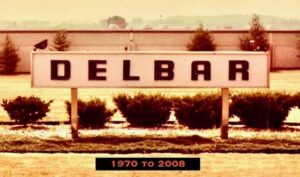
The building at 551 East Church Avenue in Telford was built in 1969 and is now home to the Secant Group — a designer-manufacturer of biomaterials and textile-based medical devices.
Delbar Products Inc. was incorporated in Pennsylvania on Nov. 30, 1923, as the Dellenbarger-Penley Co. for the purpose of “the manufacture and sale of machinery and specialties made of wood, iron, brass, steel and other materials.” The early business of the firm was manufacturing food processing equipment such as pasta slicing and chewing gum-wrapping machinery.
The early location of the facility was in the Midvale section of Philadelphia. On March 30, 1937, the name was changed to Dellenbarger Machine Co., which continued the food packaging machinery business until the start of World War II in 1941. The firm then engaged in war production, manufacturing various types of defense equipment including mechanical components for aircraft and gliders, and munitions storage racks for ships, tanks, and aircraft. The company received the Army-Navy “E” Award for “Excellence in Production” of war equipment — earned by only 5% of the companies that produced materials for the U.S. war effort.
L. Eric Jones purchased the controlling share of Dellenbarger in 1941 and became CEO. He changed the name to Delbar Products Inc. in 1945 when he purchased the company outright; it would remain Delbar until 2008, when it closed its doors.
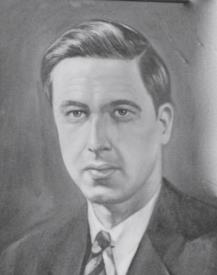
L. Eric Jones (CEO
1941-1959) was an
industrial engineer
educated at MIT.
In 1946, Jones purchased a property in Perkasie (PA) from Arrow Safety Device and took over Arrow’s product line of automotive running and stop lights. Utilizing the company’s ability to fabricate steel sheet and tubing, Jones began working on the development of a large rear-view mirror for the heavy-duty trucking industry — one that would dramatically improve rearward vision and better handle the growing commercial traffic on America’s busy post-war highways. The business grew slowly as the emphasis moved from automotive lighting to truck mirrors. But by 1953, sales volume had grown to $250,000 a year among Original Equipment Manufacturer (OEM) customers such as Mack, International, Thomas Built, Metro, Orrville, and White Motor Co. By the mid-1950s, Delbar was successful in obtaining contracts to produce heavy-duty truck mirrors for Ford Motor Co., and sales grew to $1,000,000 annually by 1959.
In February 1959, Jones succumbed to a heart attack while sailing his yacht alone in the Bermuda Triangle and was succeeded as CEO by his widow, Elizabeth H. Jones. The company’s growth continued exponentially through the 1960s with the introduction of a new, smaller “Jr. Westcoast” line of mirrors for the rapidly growing pick-up truck and van markets, and orders from Ford, General Motors and Chrysler Corp. Delbar also expanded its aftermarket business through jobbers and warehouse distributors.
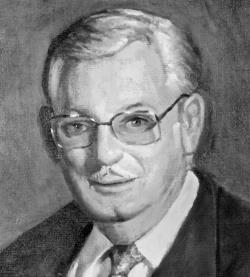
Raymond Brunner (CEO 1965-1974, 1984-1988)
was an early employee.
In 1965, Elizabeth Jones — now Mrs. R. Schuyler Lippincott — was succeeded as president and CEO by Raymond R. Brunner, one of the early employees of the firm who had been mentored by Eric Jones. She remained as chair of the board. Numerous expansions were made in the 1960s to the Perkasie facility, which stretched from Seventh and Spruce Streets two blocks to Fifth Street.
During this period of explosive growth, Delbar’s production employees chose to be represented by the International Association of Machinists, Local 152 — the same union that represented employees of Sellersville’s Ametek/US Gauge, a much larger, publicly owned corporation. Delbar would struggle with a series of lengthy labor disputes in the decades to come as the union sought wages, working conditions, and benefits matching those of Ametek’s union employees.
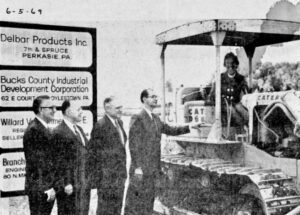
Board chair Elizabeth (Jones) Lippincott breaks ground on the $600,000 warehouse building in Telford in 1969. Company, banking, and local politicians watch. (Courtesy of the Perkasie Historical Society: Delbar Collection.)
Following a long strike in 1969, a new building was erected in Telford (PA) for the warehousing of finished goods. In 1973, the building was expanded to 120,000 square feet to accommodate Delbar’s assembly and packaging operations, which were moved there from Perkasie.
By 1974, sales had reached $19,000,000 with a total of 400 employees. That year, Brunner stepped down as President and CEO and was succeeded by Byrne Terhorst, an executive recruited from SKF, a Swedish bearing and seal manufacturing company.
Delbar continued to prosper throughout the 1970s. State-of-the-art cathode sputtering technology for the chrome plating of glass was added to the Telford facility. This allowed the company to better control the quality and cost of its reflective mirror glass and expand into specialty mirror markets such as copiers,
scanners, and transparent mirrors used in casino ceilings around the country.
By the end of the decade, employment in Perkasie and Telford reached near-full capacity with workers enjoying incentive-based wages and benefits well above average in the local community. But in the spring of ’79 came another lengthy, emotionally charged strike that shut down both plants into mid-summer. Salaried employees manned the factory equipment. But it was barely possible to meet production requirements, so several truckloads of parts, packaging, and assembly equipment were sent to an empty industrial building in Kentucky.
Within two weeks, a temporary mini-plant was set up, people were hired and trained, and finished mirrors were being shipped to fill Delbar’s most critical customer requirements. Though the effort proved unsustainable over time, much was learned about the most effective ways to relocate production. Combined with other factors that would eventually prevail, the final labor disruption proved to be a
watershed moment in Delbar history. All new products and new model manufacturing activities would now be located outside Pennsylvania.
Terhorst retired in 1982 after the company acquired a facility in Crossville, Tennessee, where the bulk of metal polishing, assembly, and packaging operations would now be located. He was succeeded briefly by Robert Keenan and Edith B. Jones, daughter of founder Eric Jones.
In July 1984, ownership of the company was assumed by a small group of investors led by Raymond R. Brunner, who once again would serve as President and CEO. This fulfilled a promise by Eric and Elizabeth Jones to give Brunner the option to buy the company if it was to be sold. Brunner had 30 days to find the funding. Richard ‘Ben’ Gerhart was a lifelong friend from Souderton who put most of the money together.
The company experienced significant sales growth in the 1980s. New mirror technologies such as electric remote-control positioning and mirror lens defrosting began to emerge and add value to the product line. Additionally, to improve mirror styling, reduce weight, and decrease door panel corrosion,
the departure from metal fabrication to plastic injection molding was being dictated by the “Big Three” automakers: Ford, GM, and Chrysler.
In 1987 Delbar opened a new plant in Cookeville, Tennessee, and moved into injection molding and plastic painting operations with new equipment, tooling, and manufacturing technology to accommodate customer demand.
Brunner actively ran the company until his death in 1988 and was succeeded by Gerhart, one of the1984 investors. As chairman and CEO, Gerhart ran the company for almost 20 years until his death in May 2007. During that period, the company expanded operations in Tennessee and opened in Queretaro, Mexico, in 1995.
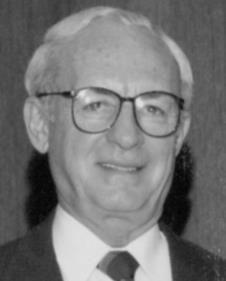
Richard Gerhart (CEO
1988-2007) was a
member of the 1984
investment group.
In 2002, with its new body-color paint operation in Crossville, Delbar began supplying passenger car mirrors for the first time. During its 85-year history, the product line had become complex and sophisticated with features that included builtin turn signal indicators, power fold mechanisms, electrochromic auto-dimming glass, puddle lamps, and more.
Delbar over the years had been a formidable competitor supplying every major OEM manufacturer of trucks, vans, and SUVs in North America. But the face of the mirror industry was changing. The players — among which Delbar had been a leader for many years — were rapidly consolidating. OEMs were making new demands including annual price reductions, a physical presence around the world wherever their auto plants were located, and a full menu of component offerings beyond just mirrors.
In early 2008, Delbar ceased activity in Pennsylvania and sold many of its assets in Tennessee and Mexico to Ficosa International, a multinational corporation. Headquartered in Spain, it had more than 9,000 employees in 19 countries throughout south and central America, Europe, and Asia. In addition to manufacturing rear view mirrors, Ficosa produces shift-by-wire and fluid controls, antennas, and driver assistance systems for vehicles. Its new 270,000-square-foot plant with more than 500 employees in Cookeville continues to produce light truck and passenger car mirrors for several OEMs throughout the US. In 2017, Panasonic Corp. purchased control of Ficosa and currently owns 69% of its stock.
During the late 1970s, Delbar had been among the area’s largest employers — second only to Ametek/US Gauge. At its height — prior to closing in 2008 — Delbar’s annual sales eclipsed $200,000,000. It employed nearly 700 employees in Pennsylvania, Tennessee, and Mexico.
Over the years Delbar provided jobs for thousands of area residents; paid millions in wages and benefits; and brought significant revenue to Telford and Perkasie as a taxpayer and consumer of locally produced tooling and supplies, electricity, water, and gas.
Because of Delbar’s major economic impact on the community, its many innovations to highway safety across America, and the admirable preservation of the building — including many of the key architectural features at 7th and Spruce — the Perkasie property was placed on the National Registry of Historic Places. It’s one of a select few properties in this area to achieve this status. The building now has been converted into The Delbar, with historically unique apartments.
But another important side of Delbar history is the human part of the story. Working at Delbar had a very special family feel about it, a camaraderie based on teamwork and accomplishment with many positive memories and relationships that went far beyond a paycheck.

That sense of family carries on. Last year, a handful of former Pennsylvania employees organized a Delbar Alumni Group, complete with a Facebook page that currently features a historic photo montage. In 2023 — the company’s 100th anniversary —150 former employees reunited at the Dublin Fire Company Hall. A member of the organizing committee told a local journalist covering the event that it was no easy task to find past Delbar employees because the company HR records had been destroyed in 2008 and many had moved or passed away.
The manufacturing sector in Souderton and Telford must cope with 21st century challenges. But the region’s long history of manufacturing and its skilled workforce provide a strong foundation with a promise of continued success in the years to come.
About the author: Alan Weisberg began his employment with Delbar in 1965 at age 18, when he was hired as a night shift paint production worker. During a 30-year career, he worked in industrial engineering, plant management and labor relations, and served as Vice President of Operations and President of the firm. He retired from Delbar in 1996 to start a consulting firm specializing in the placement of engineers and executives in the manufacturing industry. He retired from his business in 2017 and has since contributed articles to the historical society’s newsletter on a variety of local topics.
